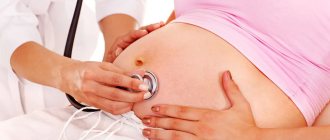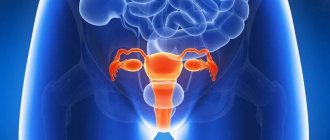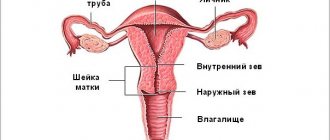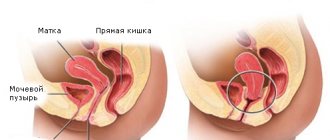Female reproductive system
The uterus is a pear-shaped organ located between the bladder and the lower intestine.
It consists of two parts, the body and the cervix. When a woman is not pregnant, the body of the uterus is approximately the size of a fist, with its walls pressed against each other. During pregnancy, the walls of the uterus move apart from each other as the fetus grows. The cervix is located at the bottom of the uterus. It has a canal bounded by the internal and external os that connects it to the vagina, which allows menstrual blood to flow from the uterus to the vagina during menstruation. The fallopian tubes. On each side of the body of the uterus there are two tubes known as the fallopian tubes. At the end of each tube are the ovaries.
The ovaries are ovum-producing organs that contain 200,000 to 400,000 follicles. These cell follicles contain the materials needed to produce mature eggs.
The inner lining of the uterus is called the endometrium. During pregnancy, this inner lining thickens and its blood vessels become engorged with blood to accommodate and support the growing fetus. If pregnancy does not occur, the endometrium leaks out as part of the menstrual cycle. Menstrual flow also consists of blood and mucus from the cervix and vagina.
Gonadotropin-releasing hormone (GnRH), a hormone from the hypothalamus that stimulates the anterior pituitary gland to produce follicle-stimulating hormones (FSH) and luteinizing hormone (LH).
Estrogen, progesterone and the male hormone testosterone are secreted by the ovaries and complete the hormonal processes necessary for a woman's reproductive health.
Diseases that cause it
During pregnancy, the intestines begin to put pressure on the uterus and all the processes that occur in it are reflected on it. For example, with increased gas formation, the intestinal walls stretch and press harder. The same thing happens with constipation and other difficulties with bowel movements. Pain and spasms in the intestines can also erode into the uterus, causing it, in addition to pressure, and pain.
If pressure on the uterus appears in the absence of pregnancy and its normal location, then there may be pathological reasons for this. For example, such as:
- Endometriosis, especially external, that is, on the outside of the walls of the organ (pain in this case usually occurs during menstruation);
- Adnexitis is an inflammation of the ovaries, pain in which can erode into the anus, which will be felt as a feeling of pressure on the uterus;
- Apoplexy (rupture) of the ovary has the same features as adnexitis;
- An ectopic pregnancy in the cervix can be accompanied by pain and erode into the intestines, which, as in the case of adnexitis, can be felt as pressure;
- Sphincteritis is an inflammation of the sphincter, accompanied by swelling, which puts pressure on the uterus;
- Neoplasms in the uterus, which can lead to the shape of the cavity changing and moving closer to the intestines, and then the rectum begins to put pressure on the uterus;
- New growths in the intestines, causing it to stretch and put pressure on the uterus;
- Inflammatory bowel syndrome, increased gas formation and flatulence are accompanied by an accumulation of gas in the rectum, which stretches and puts pressure on the uterus, as in the previous case;
- Constipation, for the same reasons.
Physiological reasons
The most common cause of this symptom is pregnancy. The gradual enlargement of the uterus with the growth of the fetus leads to compression of the bladder. Constant pressure on the organ causes a frequent urge to urinate; there are situations when a woman cannot restrain this feeling, and involuntary urination occurs. To avoid such situations, pregnant women should empty their bladder more often.
An equally common cause of tightness is a significant degree of obesity. Excess fat deposits put pressure on the bladder, causing the need to urinate frequently.
Bladder location
Let's find out what can put pressure on the bladder. This organ is located in the pelvis, in the lower abdomen. In men, the rectum and prostate gland come into contact with it, in women – the vagina and uterus. In people of both sexes, the bladder (its upper part) and the intestines (small, sigmoid, transverse colon) are adjacent to each other.
Most often, discomfort is caused by direct compression of the bladder by nearby organs. This occurs both as a result of normal physiological processes and in the presence of pathology in the body.
The feeling of pressure occurs for various reasons. Most often it appears when compressed by intestinal loops, the uterus, or the prostate gland. This activates pain receptors and baroreceptors in the wall of the bladder, which causes characteristic symptoms.
Intestines
Since the intestines are located nearby, in some diseases it puts pressure on the bladder. The symptom can occur in both women and men with the following pathologies:
- obstruction. Feces accumulate in the intestines. They clog the lumen of the sigmoid, small or transverse colon, stretching it. Larger loops take up more space. Characteristic signs: abdominal pain, bloating, flatulence, stool retention;
- benign tumor or cancer. Rarely encountered;
- intestinal inflammation. Usually of an infectious nature (causative agent - salmonella, E. coli). Accompanied by severe abdominal pain, vomiting and diarrhea. Less common are Crohn's disease or ulcerative colitis. Any inflammation is characterized by swelling. As a result, the intestines put pressure on the bladder;
- anatomical and physiological features of the body - low location of the intestines. In this case, complaints arise in childhood, and diagnosis is not difficult;
- acquired bowel prolapse. Occurs due to decreased muscle tone of the anterior abdominal wall or connective tissue dysfunction. The provoking factor is excessive physical activity. A characteristic symptom is nagging pain in the lower abdomen and painful periods in women.
In case of intestinal diseases, in addition to pressure in the bladder, other symptoms of disruption of the intestinal tract are intensely manifested.
The male body has characteristic anatomical features. The prostate gland is located at the bottom of the bladder in men.
An enlarged prostate due to prostatitis, adenoma or cancer puts pressure on the bladder. Patients complain of pain in the lower back, lower abdomen, perineum, fever and weakness.
A hollow muscular organ that is located between the bladder and rectum. It is fixed in the pelvis by ligaments and muscles.
Uterine prolapse
Occurs in young and older women. The causes of uterine prolapse are difficult childbirth, congenital pathology of the ligamentous apparatus or its wear and tear with age, and constant constipation.
A change in the normal location of the organ provokes compression of the bladder. Patients also complain of nagging lumbar pain and a sensation of a foreign body in the vagina. There is a disturbance in the menstrual cycle;
Pregnancy
Pregnancy is a natural, physiologically determined process, so it only takes time for discomfort to disappear.
As the fetus grows, the uterus stretches, enlarges and changes its position.
Tumor of the muscle tissue of the uterus of a benign nature.
It can develop on both the internal and external surfaces of the organ. When it reaches a large size, it puts pressure on the bladder.
Intestines and uterus location in the body
The uterus is a female reproductive organ that performs important functions:
- Embryo implantation, development and gestation.
- Ensuring the birth process (active participation by “pushing” the fetus).
- Endocrine function (production of the hormone relaxin).
- Menstrual.
The uterus is located in the pelvic cavity between the bladder (in front of it) and the rectum (from the back wall). Therefore, any pressure on these organs is felt, even if the woman herself does not understand where exactly the uterus itself is located, and what exactly brings her discomfort.
But since uncomfortable manifestations will definitely make themselves felt, there is a chance that the woman will soon discover the cause of the pain by visiting a doctor: pressure on the bladder will cause an endless urge to urinate, and even uncontrollable urine output - especially when coughing, sneezing or in stressful situations . And on the rectum - an excessive feeling of heaviness when the intestines are full, a feeling of incomplete emptying, frequent constipation. The impact may also be felt as a dull, vague pain in the back.
Causes of pressure and pain
The gynecologist will help the patient discover the cause of her complaints, which is a sudden increase in the size of the uterus. This may turn out to be:
- Pregnancy , when the uterus enlarges to create optimal conditions for bearing a fetus. During pregnancy, the space in the uterus should not be infringed or compressed, so it expands, causing oppression of other organs (later it will return to its almost previous size).
- Displacement (this is a congenital or acquired pathology in which the uterus changes its position. A woman experiences a sensation of a foreign body and menstrual irregularities).
- Myoma is a benign tumor that can develop both inside the organ and in the abdominal cavity. Initially, its course is asymptomatic (until it reaches a certain size). It is formed from smooth muscle and connective tissue. There can be several fibroids, and their sizes vary from 1 mm to 20 cm. Myoma is one of the most common female diseases, especially at the age of 30-40 years. Also at risk are women who have not yet been pregnant.
Why is it dangerous?
Both when affecting the intestines and the bladder, a certain danger arises, consisting not only of disease of the uterus itself, but also affecting these organs. That is, the rectum, under pressure, cannot fully perform its function, resulting in an accumulation of intestinal contents.
At the same time, toxins are not removed from the body, the gastrointestinal tract is completely exposed to suffering, leading the person to feel unwell.
If all this happens for a long time, then metabolism begins to be disrupted: excess weight and cellulite appear.
The intestines begin to respond in response to the uterus that is pressing on it, and, subsequently, all other organs located nearby are also subject to infringement.
The pressure of the uterus on the bladder will not have the same scary effects as on the bowels, but the threat of uncontrollable urination is also extremely unpleasant.
The greatest danger, as indicated by the symptom of uterine pressure on other organs, is the fibroid described above. This disease is characterized by the following symptoms: long and painful menstruation, a feeling of heaviness, periodic pain in the pelvis, lower back, back, as well as infertility and miscarriages.
But it is worth remembering that modern medicine can eliminate this disease once and for all, so there is no point in worrying that this pathology will cause problems in the future. Nevertheless, maintaining a healthy lifestyle will become mandatory: women who are not overweight and have a full sex life are many times less susceptible to this disease.
The appearance of a neoplasm in the uterus is extremely dangerous only if, upon diagnosis, it is revealed to be oncological, or in advanced cases: when, for example, a fibroid that has “grown” inside the uterus reaches such a size that it can cause bleeding, deforming it.
Diagnostics and measures aimed at eliminating the problem
If you identify painful symptoms, you must first contact a gynecologist who will conduct a consultation and prescribe a diagnosis.
If pregnancy is identified as the cause of discomfort, treatment will not be required. The patient, that is, the expectant mother, will simply need to get used to the fact that the uterus will cause such inconvenience throughout the entire pregnancy. In this case, you should carefully monitor the sensations, listening to your body.
If pregnancy is not confirmed, it is necessary to urgently conduct a diagnosis for neoplasms in the uterus - fibroids. For this purpose, ultrasound examination (ultrasound) is used, thanks to which the doctor will be able to determine the number of myomatous nodes, their location and size.
Also, in the field of diagnosis and treatment, methods such as
hysteroscopy (examination of the uterine cavity using an optical system), hysterosalpingography (ultrasound or X-ray), and the last resort method - laparoscopy (surgical removal of fibroids) are used.
Timely detection of fibroids in the uterus will help eliminate them using a gentle method - “uterine artery embolization.” The procedure is quite simple (about 10 minutes in time) and understandable: the vessels feeding the neoplasm are clogged. Blood will continue to flow into the uterus itself from other arteries and small capillaries.
If a tumor is detected, then it is extremely necessary to perform a biopsy of endometrial tissue . The sample is sent for histological analysis to rule out oncology.
Thus, the most effective way to avoid the possibility of a change in the location or enlargement of the uterus (and in general any gynecological disease) is to visit the appropriate doctor as often as possible (with an interval of 3 to 6 months).
Even if a woman is not bothered by the pressure of the uterus on other organs, this does not mean that there is no disease, or, at best, pregnancy. This is explained simply: small fibroids are physically imperceptible. And an ultrasound procedure prescribed by a doctor can show all the factors that the patient could not take into account on her own.
Uterine displacement is a non-standard arrangement of the organs of the female reproductive system, when the body of the uterus is deviated from its normal position. The position of the uterus changes when the bladder and rectum are full. Also, its location may shift if the muscles and ligaments of the pelvis weaken.
The position of the uterus is determined in a standing woman of childbearing age after emptying the bladder and rectum. The uterus should be located in the center of the small pelvis at an equal distance from its walls, the center of the pubis and the sacrum. The organ is attached to the walls of the pelvis by a ligamentous apparatus.
In a normal position, the body and cervix form an obtuse angle directed forward.
In a healthy woman, the uterus lies in the pelvic cavity, 2 cm short of the upper edge of the pubic joint, its bottom looks forward, the neck back, bending slightly in the area of the internal pharynx and forming an angle open anteriorly, held by a special ligamentous apparatus.
In a healthy state, the uterus has mobility: when breathing, it lowers and rises, when the bladder is full, it rises up and back, when the rectum is full, forward and to the right.
This mobility of the uterus allows it to expand and rise upward during pregnancy, making possible various displacements of the uterus in the pelvic cavity in a non-pregnant state. These displacements sometimes produce painful effects, but sometimes they do not bring any harm to the woman.
Here we will examine only those displacements of the uterus that cause painful phenomena and are most common. These include:
Inclinations and bends of the uterus
The inclination of the uterus is the change and position of the axis of the uterus in relation to the axis of the pelvis, whereby the shape of the uterus sometimes remains unchanged, but sometimes it extends into a straight line.
The inflection of the uterus is a position in which the body of the uterus forms an acute angle with the cervix, open to the pubic joint or sacrum, and therefore a distinction is made between the inflection of the uterus forward and the inflection of the uterus backward.
These uterine inclinations and inflections can be in all directions, but we will analyze only the two main ones:
Mood. When the uterus is tilted forward, the axis of the uterus is elongated almost in a straight line: the fundus is facing forward, the cervix is facing back. The fundus of the uterus, pressing on the bladder, irritates it and causes frequent urination; the cervix, resting on the rectum, is a common cause of constipation.
Forward inclination of the uterus is congenital, but sometimes it is caused by childbirth, abortion, hard work, etc. This position of the uterus prevents pregnancy.
The forward tilt of the uterus in pregnant women develops from stretching of the abdominal walls, due to flaccidity of the abdominal muscles caused by numerous pregnancies.
Source: https://okishechnike.com/info/kishechnik-i-matka-raspolozhenie-v-organizme/











